Volunteers make up 87% of emergency responders in Australia. They arrive at their volunteering role with education, training, professional qualifications and life experience. This is an asset of enormous potential value, hiding in plain sight.
This asset can be exploited to engage volunteers, and to improve education, development and retention. It can also enable the sector to find new solutions to problems through innovation and collaboration.
Youth Development and Retention Project
The National SES Volunteers Association (NSESVA) views the development and retention of younger members as a critical issue for future capability. To boost youth engagement, the NSESVA Board sponsored a contingent of young State Emergency Service (SES) volunteers to participate in the AFAC National Memorial Service in Canberra. Comprised of representatives from each state and territory SES agency, the youth contingent was invited to tour Canberra, including Parliament House, Geoscience Australia (receiving a briefing on its role in emergency services) as well as the ACT Emergency Services Training Centre and ACT Emergency Services Operations Centre. The final night included a special dinner and presentation where each member of the youth contingent presented a 4-minute speech as part of their development.
The first contingent attended the 2019 AFAC National Memorial Service. The attendance of the youth contingent was cancelled in 2020 and 2021 due to uncertainty of travel and border restrictions. It is intended that the youth contingent will recommence participation of the National Memorial Service and Canberra tour in 2022 and is expected to increase to 2 representatives per jurisdiction.
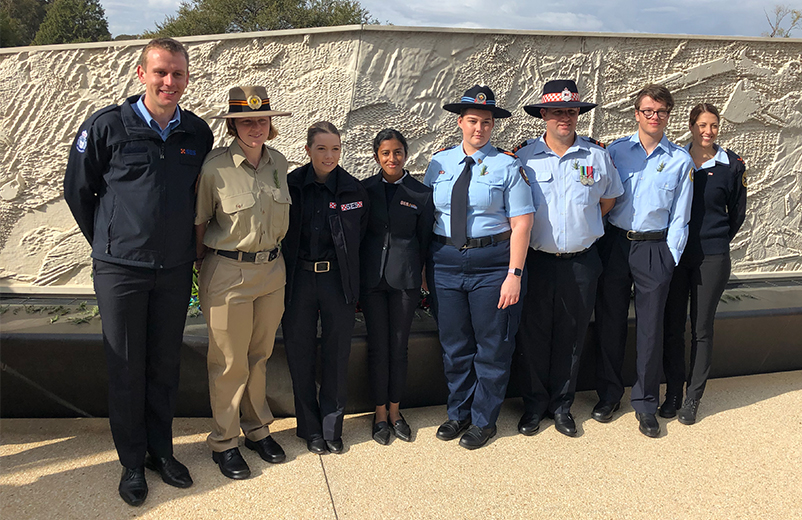
The 2019 youth contingent attending the AFAC national memorial service.
Image: Faye Bendrups
The Refuge Project
Emergency services agencies have an increasing focus on connecting with communities and assisting them to develop a shared responsibility for their own safety. However, communities may never be involved with the emergency management sector and emergency services agencies may not have a full understanding of diverse communities. One project that took a different approach is the Refuge Project1 in Melbourne that was led by creative artists and involved migrants and refugees, local schools and Aboriginal and Torres Strait Islander peoples.
The Refuge Project has run for 6 years at the North Melbourne Arts House. The venue operates as an arts centre but is also a designated relief centre in the City of Melbourne’s emergency preparedness plan. Refuge has conducted artist residencies, online panel discussions, emergency simulations and a major annual public event based on a different theme each year. Partners in the project include the Australian Red Cross, St John Ambulance and the local VICSES Footscray Unit, whose response territory includes the City of Melbourne.
The project’s website explains:
Refuge drops us in the hot zone of different climate-related disasters. Flood, heat, pandemic and displacement: this five-year project offers us new ways to rally as a community and prepare for climatic events. Refuge brings together people who might not normally collaborate in a crisis, including local residents, artists, scientists, Elders and experts from the world of emergency services. Their task is to identify what matters when the unthinkable becomes real: what being prepared means in the face of disaster, how the survival of the individual is inextricably bound up with the survival of community, and what role we can each play if the worst comes to pass.
In 2016, Refuge transformed the North Melbourne Town Hall into a relief centre for 24 hours in response to a hypothetical flood. In 2017, Refuge ran a similar exercise in response to a hypothetical heatwave, responding to the city’s increasing risk of experiencing 5 consecutive days over 40°C. In 2018, Refuge partnered with the Doherty Institute and participated in a pandemic simulation exercise with the City of Melbourne. Refuge asked: what happens to the social and environmental fabric of a city through the risk of contagion or quarantine? It explored health effects of climate change, epidemics, grief, stigma and anxieties invoked by the language of disease. Participants and visitors kitted up in full personal protective equipment, masks, gloves and suits.
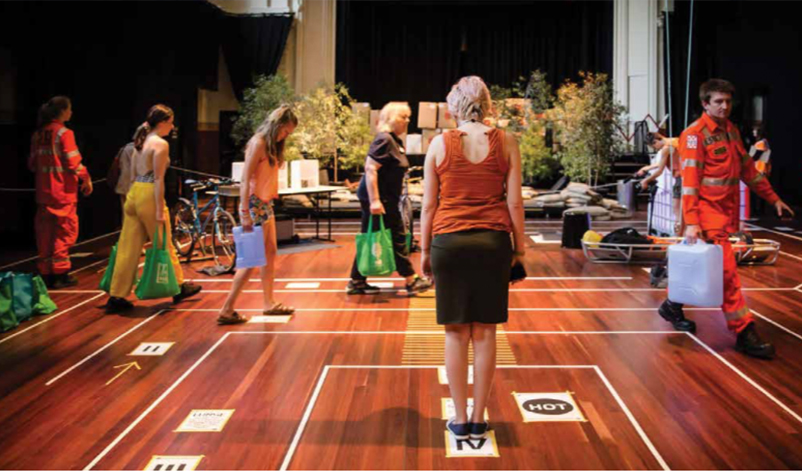
Refuge 2017: Volunteers conduct a walk through of a heatwave simulation game.
Image: Faye Bendrups
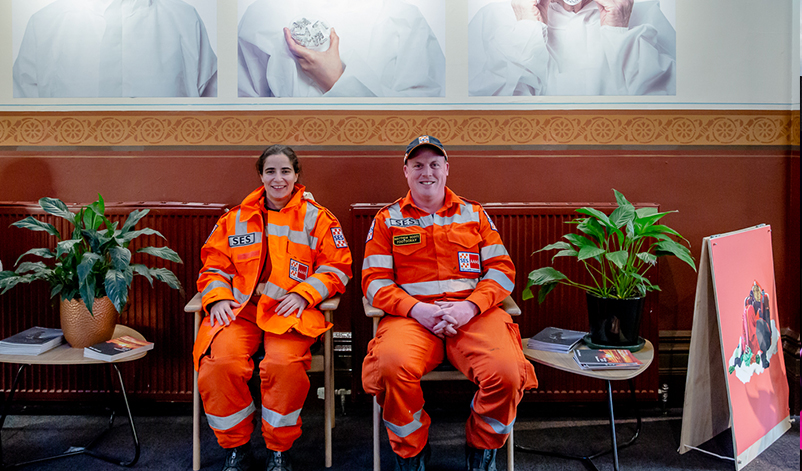
Refuge 2018: SES volunteers received pre-pandemic experience in the pandemic simulation.
Image: Faye Bendrups
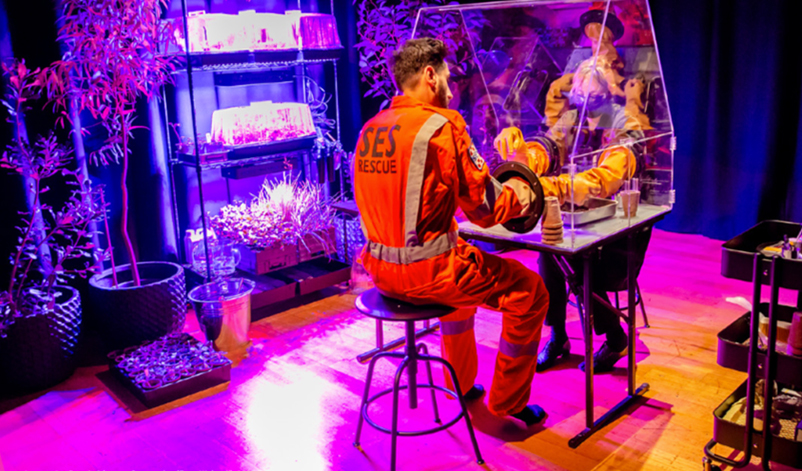
Refuge 2018: Introducing the concept of physical distancing at the pandemic simulation.
Image: Refuge
In 2019, Refuge explored the issue of displacement prompted by climate change and extreme weather. This was to be in 2 parts, with the second to occur in 2020. However, due to lockdowns in Victoria, it did not go ahead and was postponed to 2022, the final Refuge. It explores the confluence of multiple climate crises and asks: how can we share resources equally in times of hardship when the worst comes to pass?
VICSES Footscray Unit provided information and advice; the Controller was part of discussion panels and ran a workshop on local evacuations, Street Plan: The Big Brainstorm. In 2021, they worked with Latai Taumoepeau’s project, Mass Movement, and participated in a symbolic walk and a mass gathering representing movements of climate change refugee Pacific Island groups whose islands are at risk of catastrophic inundation. The SES members also participated in a multi-day workshop that involved local communities experimenting with the construction of temporary shelters as part of the Portage: Shelter2Camp project. This workshop was devised by Jen Rae and guided by local Australian Indigenous, Papua New Guinea and Sudanese residents who shared their construction methods for building nomadic or temporary structures.
The Research Unit in Public Cultures at the University of Melbourne noted that a distinguishing characteristic of Refuge is ‘its rejection of command-and-control approaches to decision-making and vertical communication systems in favour of horizontal communications and the embrace of collective decision-making’.2 It was overwhelmingly agreed that the ‘playing in the dark’ strategy that unfolded during Refuge enabled exciting new pathways for emergency management planning.3
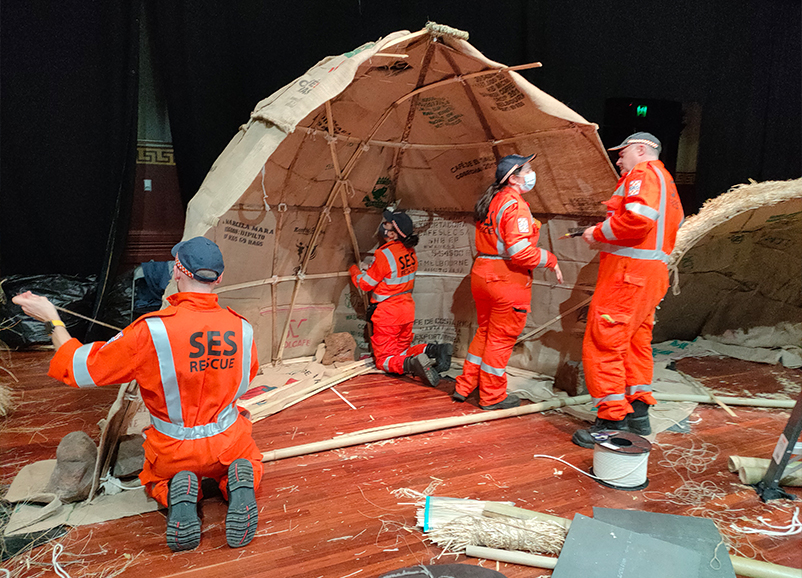
Refuge 2021: Displacement. SES personnel building a temporary shelter.
Image: Faye Bendrups
Transport solutions to enhance operational capability
During the bushfires south of Perth in the summer of 2013–14, it was identified that many of the firefighting assets were driven from the fire ground back to their base 2 to 5 hours away. This meant that not only were the assets unavailable for firefighting during this period, but that fatigued crews were driving themselves back after their firefighting shift was completed. The acquisition of 8 buses for the transport of SES and firefighting volunteers was an initiative of SES volunteers in Western Australia (WA SESVA).
In early 2014, 3 SES volunteers met with BHP Billiton to discuss sponsorship. During these discussions, the SESVA team outlined the role and support to the community by the SES volunteers and the other services and put forward a proposal for around $100,000.
One of the proposals involved assisting the firefighters by transporting them to and from the assembly areas, thus leaving fire trucks and equipment near the fire ground and decreasing the amount of downtime of equipment. This would require strategically located buses. The benefits included leaving the assets at the fire front while swapping the crews in the field and transporting the firefighters safely to and from the assembly areas. The proposal meant that 5 buses would be located in the outer metropolitan area to support firefighters as well as SES, one bus to be central in Perth and 2 located in the Pilbara for rescue support and changing SES crews during extended Karijini Gorge rescues and road crash rescue crews on remote highways.
As a result of these discussions, the SESVA put a proposal to BHP Billiton for a community grant to supply 8 buses, including maintenance, registration and licensing for 5 years. The project for the supply and delivery of the 8 buses was managed by the SES Volunteers Association.
The metropolitan-based buses were delivered in December and January 2014–15 with the delivery of the Newman and Karratha buses in February of 2015. One of the key aspects of this project was the fast turnaround time from initial discussions to the delivery of the buses of only 10 months. Since then, the buses have been extensively used in all type of emergencies, especially for bushfire support in delivery of firefighters to staging areas, and the swapping of crews in remote areas during rescues and road crash rescue activities.
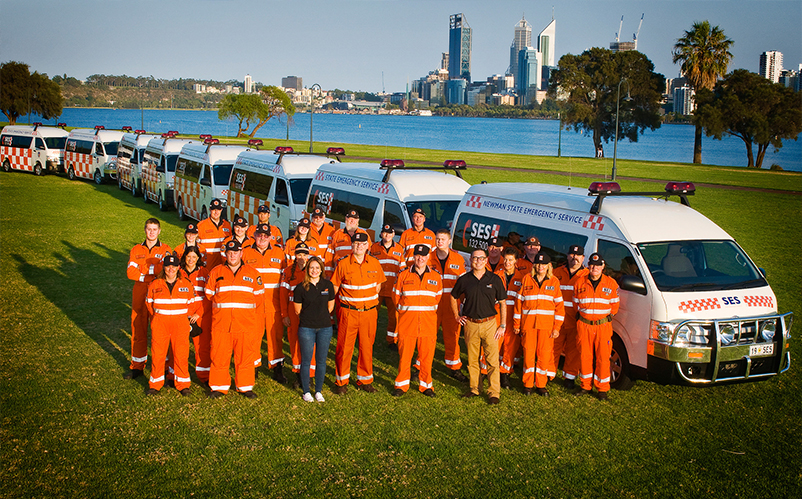
A fleet of commuter buses ferry personnel to and from fire grounds.
Image: Gordon Hall
Conclusion
There are many ways volunteers can contribute new perspectives, new ideas or new initiatives to the emergency management sector; whether developing future leaders, negotiating with multinationals or taking creative chances on novel approaches to disasters. Imagine the added value to the sector if their skills and experience – hiding in plain sight – could be collated, recorded and capitalised on. We challenge the sector: Let’s harness the potential of volunteers and maximise the innovation and collaboration possibilities they represent.


